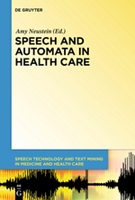Chapter 8 Voice-enabled assistive robots for handling autism spectrum conditions
an examination of the role of prosody
| dc.contributor.author | Marchi, Erik | |
| dc.contributor.author | Ringeval, Fabien | |
| dc.contributor.author | Schuller , Björn | |
| dc.contributor.editor | Neustein, Amy | |
| dc.date.accessioned | 2019-11-14 23:55 | |
| dc.date.accessioned | 2020-01-07 16:47:06 | |
| dc.date.accessioned | 2020-04-01T09:29:22Z | |
| dc.date.available | 2020-04-01T09:29:22Z | |
| dc.date.issued | 2014 | |
| dc.identifier | 1006344 | |
| dc.identifier | OCN: 1135846156 | en_US |
| dc.identifier.uri | http://library.oapen.org/handle/20.500.12657/23796 | |
| dc.description.abstract | Autism spectrum conditions (ASC) are neurodevelopmental conditions, characterized by impairments in social interaction, communication (i.e., verbal and non-verbal language), and by restricted interests and repetitive behaviour. The application of robots as a therapy tool has, however, shown promising results, namely because of the robot’s ability to improve social engagement by eliciting appropriate social behaviour in children with ASC. Robots can also help clinicians in the diagnosis of ASC, by providing objective measurements of atypical behaviours that are collected during spontaneous interactions between autistic children and automata. In this chapter, we provide a review of real-life examples of voice-enabled assistive robots in the context of ASC, examining the critical role prosody plays in compensating for the lack of robust speech recognition in the population of children with ASC. This is followed by a critical analysis of some of the limitations of speech technology in the use of socially assistive robotics for young persons suffering from ASC. | |
| dc.language | English | |
| dc.subject.classification | thema EDItEUR::T Technology, Engineering, Agriculture, Industrial processes::TB Technology: general issues::TBC Engineering: general | en_US |
| dc.subject.classification | thema EDItEUR::U Computing and Information Technology | en_US |
| dc.subject.classification | thema EDItEUR::U Computing and Information Technology::UY Computer science::UYS Digital signal processing (DSP) | en_US |
| dc.subject.other | speech processing | |
| dc.subject.other | speech automata | |
| dc.subject.other | assistive robots | |
| dc.subject.other | robot companions | |
| dc.subject.other | human-robot interaction | |
| dc.title | Chapter 8 Voice-enabled assistive robots for handling autism spectrum conditions | |
| dc.title.alternative | an examination of the role of prosody | |
| dc.type | chapter | |
| oapen.identifier.doi | 10.1515/9781614515159.207 | |
| oapen.relation.isPublishedBy | 2b386f62-fc18-4108-bcf1-ade3ed4cf2f3 | |
| oapen.relation.isPartOfBook | 435c02d4-ba47-4a64-a93c-16947c2d95dd | |
| oapen.relation.isFundedBy | 7292b17b-f01a-4016-94d3-d7fb5ef9fb79 | |
| oapen.relation.isbn | 9781614517092; 9781614519607 | |
| oapen.collection | European Research Council (ERC) | |
| oapen.place.publication | Berlin/Boston | |
| oapen.grant.number | 338164 | |
| oapen.grant.acronym | IHEARU | |
| oapen.identifier.ocn | 1135846156 |

